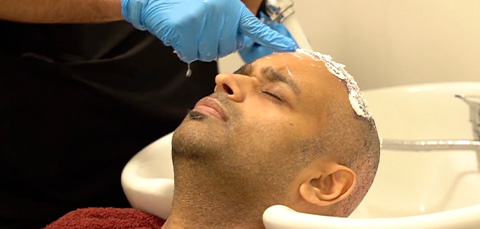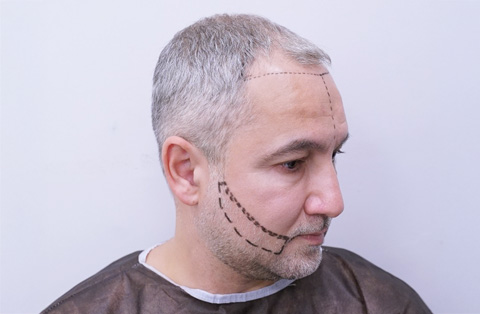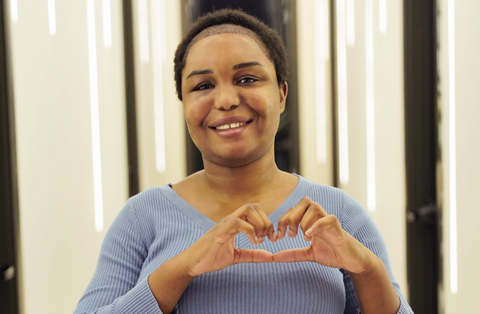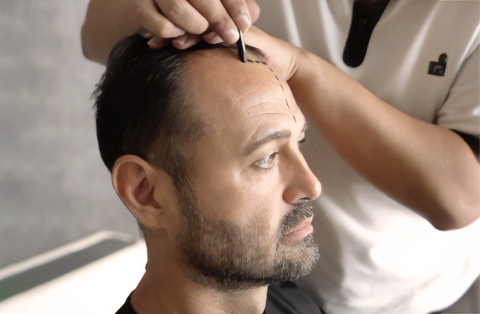Follicular Unit Transplantation (FUT) stands as a cornerstone in the field of hair restoration, representing a traditional yet highly effective method for combating hair loss. Its development and refinement over the years have made it a staple procedure in hair transplant clinics worldwide.
Overview of FUT as a Traditional and Effective Hair Transplant Method:
FUT, commonly referred to as the ‘strip method,’ involves the removal of a strip of scalp from the donor area, typically at the back of the head where hair is more resistant to balding. This strip is then meticulously dissected under a microscope into individual follicular units, which contain one to four hairs each. These units are then transplanted into the balding areas of the scalp.
FUT is particularly noted for its ability to provide a substantial number of grafts in a single session, making it an ideal choice for patients with significant hair loss. The method is celebrated for its high graft survival rate and ability to achieve natural-looking results, restoring not just hair, but also confidence and self-esteem for many individuals.
The Evolution of Hair Transplant Techniques Leading to the Development of FUT:
The journey to FUT began with more primitive hair transplant techniques that often resulted in unnatural-looking results. Over time, medical advancements led to the development of the FUT method, which allowed for a more natural distribution of hair.
The technique evolved from the larger grafts of the past to the refined extraction of follicular units, ensuring a seamless blend with existing hair. This evolution marked a significant shift in hair transplantation, moving towards procedures that prioritize aesthetic outcomes and patient satisfaction.
FUT’s development reflects the medical community’s commitment to combining surgical expertise with artistic finesse, continually improving techniques to meet the evolving needs and expectations of patients.
In summary, FUT is a testament to the advancements in hair restoration techniques. Its enduring presence in the field is a testament to its effectiveness and the satisfaction it has brought to countless patients seeking a solution to hair loss.
Related Contents:
- Best Hair Transplant Techniques
- Follicular Unit Extraction (FUE) Hair Transplant
- DHI Hair Transplant
- Sapphire FUE Hair Transplant
What is Follicular Unit Transplantation (FUT)?
Follicular Unit Transplantation (FUT) is a well-established hair transplant technique that has been widely used for several years. It is known for its effectiveness in treating significant hair loss by transplanting a large number of hair follicles in a single session.
Detailed Explanation of the FUT Process:
- Donor Strip Extraction: The FUT process begins with the surgeon removing a strip of scalp from the donor area, usually at the back of the head. This area is chosen because the hair follicles here are genetically resistant to balding.
- Dissection of Follicular Units: The extracted strip is then carefully dissected under a microscope into individual follicular units. Each unit typically contains one to four hair follicles.
- Preparation of the Recipient Site: Small incisions are made in the recipient area of the scalp, where hair loss has occurred.
- Transplantation: The dissected follicular units are then meticulously transplanted into these incisions. The surgeon places them in a way that mimics the patient’s natural hair growth pattern, ensuring a natural-looking result.
- Closure of Donor Area: The area where the strip was taken is then sutured or stapled closed, leaving a linear scar that is typically concealed by the patient’s remaining hair.
How FUT Differs from Other Hair Transplant Methods, Particularly FUE:
- Method of Hair Follicle Extraction: The primary difference between FUT and FUE (Follicular Unit Extraction) lies in the method of extraction. While FUT involves removing a strip of scalp, FUE involves extracting individual hair follicles directly from the scalp.
- Scarring: FUT leaves a linear scar in the donor area, whereas FUE leaves multiple small, dot-like scars scattered across the donor area.
- Efficiency in Treating Large Areas: FUT is often preferred for treating larger areas of hair loss, as it allows for the transplantation of a greater number of follicles in a single session compared to FUE.
- Recovery Time: The recovery time for FUT can be slightly longer than FUE due to the healing of the linear scar.
- Suitability: FUT is often recommended for patients who require a significant number of grafts and are less concerned about the visibility of a linear scar.
In summary, FUT is a highly effective method for hair transplantation, especially suitable for patients with extensive hair loss. It differs from FUE in terms of the extraction process and the nature of scarring, with each method having its own advantages and considerations.
Benefits of FUT Hair Transplant
Follicular Unit Transplantation (FUT) offers several significant benefits, making it a preferred choice for many individuals experiencing extensive hair loss. Its efficiency, high graft survival rate, and cost-effectiveness are among the key advantages that make FUT a popular hair restoration method.
Efficiency in Covering Large Areas of Hair Loss:
- Maximizing Grafts in a Single Session: FUT is particularly efficient for treating large areas of baldness because it allows for the transplantation of a substantial number of hair follicles in one session. This efficiency is due to the method of extracting a strip of hair-bearing scalp, which can yield a high volume of grafts.
- Reduced Number of Sessions: For patients with significant hair loss, FUT can often achieve the desired coverage in fewer sessions compared to other methods, such as FUE (Follicular Unit Extraction).
High Graft Survival Rate and Natural-Looking Results:
- High Graft Quality: The technique used in FUT ensures that the integrity of the follicular units is maintained during extraction, leading to a high survival rate of the transplanted grafts.
- Natural Hair Growth Pattern: The careful placement of follicular units allows for a natural-looking hairline and hair density. Surgeons can strategically place the grafts to mimic the patient’s natural hair growth pattern, enhancing the overall aesthetic outcome.
- Long-Term Results: The results of FUT are typically long-lasting, with the transplanted hair continuing to grow naturally over time.
Cost-Effectiveness Compared to Other Hair Transplant Methods:
- Economical for Large Scale Transplants: FUT is often more cost-effective than FUE when it comes to treating large areas of hair loss. The ability to transplant a high number of grafts in a single session reduces the overall cost for patients requiring extensive restoration.
- Lower Per-Graft Cost: Generally, the cost per graft in FUT is lower compared to FUE, making it a more economical option for patients needing a large number of grafts.
In summary, FUT is a highly beneficial hair transplant method, especially for individuals with extensive hair loss. Its ability to efficiently cover large areas, combined with a high graft survival rate and cost-effectiveness, makes it an attractive option for those seeking a reliable and effective solution to hair restoration.
The FUT Procedure Step-by-Step
Understanding the Follicular Unit Transplantation (FUT) process can help you feel more comfortable if you’re considering this treatment. Here’s a step-by-step guide:
Pre-Procedure Preparations and Patient Evaluation:
- Consultation: Your journey starts with a detailed consultation. Your doctor will assess your hair loss and discuss your goals. This step is crucial to ensure FUT is the right choice for you.
- Planning the Procedure: Your doctor will plan where to take the hair from (usually the back of your head) and where it will be placed. This planning is key to achieving a look that feels natural.
Detailed Walkthrough of the FUT Procedure:
- Step 1: Removing the Hair Strip: The procedure begins with the removal of a strip of hair from the donor area. This strip is carefully chosen to ensure the best possible results.
- Step 2: Preparing the Grafts: The strip is then divided into individual follicular units under a microscope. Each unit contains a few hairs.
- Step 3: Transplanting the Hair: The doctor makes tiny incisions in the balding area and carefully places the follicular units. This step requires skill to ensure the hair grows in a natural pattern.
- Step 4: Closing Up: The donor area is closed with sutures, leaving a linear scar that is typically hidden by your hair.
Post-Procedure Care and Recovery:
- Aftercare Instructions: You’ll receive detailed instructions on how to care for your scalp. Following these closely is important for your recovery and the success of the transplant.
- Healing Process: Some swelling or discomfort is normal, but it usually subsides quickly. The donor area will heal, leaving a scar that’s generally not noticeable.
- Seeing the Results: Patience is key. You’ll start to see new hair growth in a few months, with the final results visible after about a year.
Remember, FUT is a significant decision. Understanding each step helps you know what to expect and ensures you’re prepared for the journey to fuller hair.
FUT Scarring and Healing
When considering Follicular Unit Transplantation (FUT), it’s important to understand the aspects of scarring and the healing process. Here’s what you need to know:
Understanding the Linear Scarring Associated with FUT:
- Scar Formation: FUT involves removing a strip of scalp from the donor area, which is then sutured back together. This process leaves a linear scar.
- Scar Appearance: The scar is typically located in an area that’s easily concealed by your existing hair. Its visibility can vary based on the surgical technique used, the size of the strip removed, and your body’s healing process.
- Managing Scar Visibility: In most cases, the scar is not noticeable, especially under longer hair. If scar visibility is a concern, discuss it with your surgeon, as they can adjust the technique to minimize its appearance.
The Healing Process and What to Expect Post-Surgery:
- Immediate Post-Op: After the procedure, you’ll likely experience some discomfort and swelling, which is normal. Your surgeon will provide pain management options and care instructions.
- Healing Timeline: The donor area usually heals within a few weeks. The sutures might be removed or will dissolve, depending on the type used.
- Hair Growth: Initially, the transplanted hair will shed – this is a normal part of the process. New growth typically begins after a few months, with the full results visible within a year.
- Long-Term Care: Follow your surgeon’s advice on caring for your scalp to ensure the best healing and hair growth. This may include specific washing instructions, avoiding certain activities, and attending follow-up appointments.
Understanding scarring and the healing process is key to setting realistic expectations for your FUT procedure. Remember, each person’s experience can vary, and your surgeon is there to guide you through every step of your hair restoration journey.
Cost of FUT Hair Transplant
The cost of a Follicular Unit Transplantation (FUT) can vary widely, influenced by several factors. Understanding these can help you plan financially for the procedure.
Factors Influencing the Cost of FUT Procedures:
- Extent of Hair Loss: The more extensive your hair loss, the more grafts you’ll need, which can increase the cost.
- Surgeon’s Expertise: The experience and reputation of your surgeon play a significant role in the cost. Top surgeons often charge more for their expertise.
- Location of the Clinic: Prices can vary based on the clinic’s location. Clinics in major cities or high-cost living areas might charge more.
- Additional Treatments: Sometimes, additional treatments or procedures are needed, which can add to the overall cost.
Comparison of FUT Costs with Other Hair Transplant Methods:
- FUT vs. FUE: FUT is often less expensive than FUE (Follicular Unit Extraction) because it’s less time-consuming and requires fewer resources.
- FUT vs. Other Methods: Compared to newer techniques, FUT generally remains a more cost-effective option, especially for covering larger areas.
Cost of FUT Hair Transplant in the UK, Turkey, and Other Countries:
- In the UK: The cost of FUT in the UK can vary, but it’s generally in the mid to high range due to the higher cost of living and operating expenses. The average cost of a hair transplant in the UK is approximately £4,820. However, prices can range from as low as £1,995 to as high as £15,000, depending on the clinic and the extent of the procedure.
- In Turkey: Turkey is known for offering more affordable FUT procedures without compromising on quality, making it a popular destination for medical tourism. The average cost of FUT Hair Transplant in Turkey ranges from $1,500 to $3,500. This often includes additional services like consultations, medications, local anesthesia, and sometimes even accommodation and transport.
- In Other Countries: The cost can vary significantly. In some countries, it might be lower due to lower operational costs, while in others, it might be higher.
It’s important to remember that while cost is a significant factor, the quality of care, the surgeon’s expertise, and the expected outcomes are equally important. Always consider these factors alongside the price when planning for your FUT hair transplant.
FUT vs. FUE, Sapphire FUR and DHI
When exploring hair restoration options, it’s crucial to understand the different techniques available. Each method, from Follicular Unit Transplantation (FUT) to the more recent Direct Hair Implantation (DHI), offers unique benefits and suits different needs. In this comparison, we delve into the specifics of FUT, Follicular Unit Extraction (FUE), its advanced variant Sapphire FUE, and DHI.
Follicular Unit Transplantation (FUT):
FUT, also known as the strip method, involves removing a strip of scalp from the donor area (usually the back of the head). This strip is then dissected into individual follicular units, which are transplanted to the balding areas. It’s efficient for transplanting a large number of grafts in a single session.
Follicular Unit Extraction (FUE):
FUE involves extracting individual hair follicles directly from the scalp using a micro punch tool. These follicles are then transplanted to the balding areas. It’s less invasive than FUT, leaving multiple small, dot-like scars.
Sapphire FUE:
This is a variation of FUE that uses blades made from sapphire instead of steel. The sapphire blades create finer incisions, which can lead to reduced trauma, faster healing, and potentially higher precision in graft placement.
Direct Hair Implantation (DHI):
DHI is a form of FUE where hair follicles are extracted and then directly implanted into the balding areas using a specialized pen-like tool. This method allows for more control over the depth, direction, and angle of implantation.
Comparison Chart of Hair Transplantation Techniques:
Feature/Technique | FUT | FUE | Sapphire FUE | DHI |
Scarring | Linear scar at donor site | Small, scattered dot-like scars | Minimal, fine dot-like scars | Minimal, fine dot-like scars |
Procedure | Strip of scalp removed, dissected into units | Individual follicles extracted directly | Uses sapphire blades for finer incisions | Direct implantation of follicles |
Healing Time | Longer due to linear scar | Quicker, less invasive | Faster due to finer incisions | Quick, minimal invasion |
Precision | Less precise, suitable for volume | Precise, suitable for detailed work | Enhanced precision with sapphire blades | High precision, control over implantation |
Suitability | Large areas of baldness | Smaller areas, detailed work | High-density, detailed work | Detailed work, high control needed |
Cost | Generally lower | Higher than FUT | Higher than traditional FUE | Comparable to or higher than FUE |
Each of these techniques has its unique advantages and considerations. The choice depends on individual needs, the extent of hair loss, personal preferences, and the surgeon’s recommendation.
Choosing the Right Clinic for FUT
Selecting the right clinic and surgeon for Follicular Unit Transplantation (FUT) is a critical decision that can significantly impact the success of your hair transplant. Here are some guidelines to help you make an informed choice:
Criteria for Selecting a Clinic and Surgeon for FUT:
- Surgeon’s Expertise: Look for a surgeon with extensive experience and a proven track record in performing FUT procedures. Their expertise is crucial for ensuring a successful outcome.
- Clinic’s Reputation: Research the clinic’s history and reputation in hair transplantation. Read reviews, testimonials, and look at before-and-after photos of previous patients.
- Technological Advancements: Choose a clinic that uses the latest technology and techniques in hair transplantation. Advanced equipment can lead to more precise results and a smoother recovery.
- Personalized Approach: Ensure the clinic offers a personalized approach to hair transplantation. Your surgeon should understand your specific needs and tailor the procedure accordingly.
- Consultation Process: A thorough consultation is essential. The surgeon should evaluate your hair loss, discuss your expectations, and explain the procedure in detail.
The Importance of Expertise and Technology in Successful FUT Outcomes:
- Quality of Results: The expertise of the surgeon directly influences the quality of the results. An experienced surgeon can ensure natural-looking hair growth and optimal graft survival.
- Reduced Complications: Advanced technology and surgical skill can minimize the risk of complications and ensure a more comfortable recovery process.
- Patient Satisfaction: A clinic that combines skilled surgeons with state-of-the-art technology is more likely to achieve high patient satisfaction rates.
In summary, choosing the right clinic and surgeon for FUT involves careful consideration of their expertise, technology, reputation, and approach to patient care. Taking the time to research and select a clinic that meets these criteria can significantly enhance the likelihood of a successful and satisfying hair transplant experience.
FUT in Turkey: Why It’s a Popular Destination
Turkey has emerged as a leading destination for Follicular Unit Transplantation (FUT) hair transplants, attracting patients from all over the world. Let’s explore why Turkey has gained such popularity in this field.
Popularity of FUT Hair Transplants in Turkey:
- High-Quality Medical Services: Turkey is renowned for its high standard of medical care, especially in hair transplantation. The country boasts state-of-the-art clinics equipped with the latest technology and staffed by experienced medical professionals.
- Cost-Effectiveness: One of the primary reasons for Turkey’s popularity in hair transplantation is its cost-effectiveness. Patients can often receive high-quality FUT procedures at a fraction of the cost they would pay in other countries, without compromising on the quality of care.
- Experienced Surgeons: Turkey is home to some of the world’s most skilled hair transplant surgeons, many of whom specialize in FUT. These surgeons bring years of experience and expertise, contributing to the high success rates of the procedures.
Factors Contributing to the Choice of Turkey for FUT Procedures:
- Comprehensive Care Packages: Many Turkish clinics offer all-inclusive packages for international patients, which cover the procedure, accommodation, and sometimes even transportation. This makes the entire process convenient and stress-free for patients traveling from abroad.
- Cultural and Touristic Appeal: Turkey’s rich history and culture, combined with its beautiful landscapes and landmarks, make it an attractive destination for medical tourists. Patients often take the opportunity to explore the country before or after their procedure.
- Positive Patient Testimonials: The growing number of positive reviews and testimonials from patients who have undergone FUT in Turkey further bolsters the country’s reputation as a top destination for hair restoration.
In conclusion, Turkey’s combination of high-quality medical services, cost-effectiveness, experienced surgeons, and comprehensive care packages, along with its cultural appeal, make it a highly sought-after destination for FUT hair transplants. Patients not only benefit from the advanced medical care but also enjoy the overall experience of visiting a country rich in history and culture.
Longevity and Maintenance of FUT Hair Transplants
Understanding the longevity and maintenance of Follicular Unit Transplantation (FUT) hair transplants is crucial for anyone considering this procedure. Here’s what you need to know about the lasting effects and how to maintain them.
How Long FUT Hair Transplant Results Last?
FUT hair transplant results are typically long-lasting and can be considered permanent. The transplanted hair is genetically resistant to balding, so it should continue to grow for a lifetime. However, it’s important to remember that your natural hair will continue to age and may thin over time.
- Long-Term Results: One of the most significant advantages of FUT hair transplants is their longevity. The transplanted hair is genetically resistant to balding, which means the results are typically permanent.
- Natural Aging Process: While the transplanted hair generally doesn’t fall out, your natural hair will continue to age. This means you may experience further hair thinning or loss in other areas of your scalp as you age.
Maintenance and Care for Long-Term Success:
- Post-Procedure Care: Immediately following the procedure, it’s important to follow your surgeon’s instructions carefully. This includes how to wash your hair, manage swelling, and when to return to normal activities.
- Regular Check-Ups: Schedule follow-up appointments with your surgeon to ensure your scalp is healing properly and the transplanted hair is growing as expected.
- Healthy Lifestyle: Maintaining a healthy lifestyle can contribute to the longevity of your transplant. This includes a balanced diet, regular exercise, and avoiding smoking.
- Hair Care Routine: Develop a gentle hair care routine. Avoid harsh chemicals and treatments that could damage your hair.
- Sun Protection: Protect your scalp from sun exposure, especially in the months following your transplant, as the scalp can be more sensitive.
In summary, FUT hair transplants offer long-lasting results, but the longevity can be influenced by your overall health and how you care for your hair. Following your surgeon’s advice and maintaining a healthy lifestyle are key to preserving the results of your transplant for years to come.
Frequently Asked Questions
How much does a FUT hair transplant cost?
The cost of a FUT hair transplant varies based on factors like the extent of hair loss, clinic location, and surgeon’s expertise. On average, it can range from a few thousand to several thousand dollars.
How to sleep after FUT hair transplant?
After a FUT hair transplant, it’s recommended to sleep with your head elevated on pillows for the first few nights to reduce swelling. Avoid sleeping on your stomach or sides to protect the transplanted area.
Is FUT hair transplant worth it?
FUT hair transplant can be worth it for those with significant hair loss, as it efficiently covers large areas and offers long-lasting results. Satisfaction depends on individual expectations and the procedure’s outcome.
Does FUT hair transplant hurt?
During the FUT procedure, local anesthesia is used, so you shouldn’t feel pain. Post-surgery, there may be some discomfort, but it’s typically manageable with prescribed pain medication.
Is FUT hair transplant permanent?
Yes, FUT hair transplant is considered permanent. The transplanted hair is resistant to the typical patterns of balding and should continue to grow throughout your life.
What happens 10 years after hair transplant?
Ten years after a hair transplant, the transplanted hair generally continues to grow. However, your natural hair may continue to thin or recede, depending on your genetic predisposition and age-related factors.
Conclusion
Follicular Unit Transplantation (FUT) stands as a significant option in the realm of hair restoration, offering a blend of efficiency, effectiveness, and lasting results. As we’ve explored, FUT is particularly suited for those with extensive hair loss, providing a solution that covers large areas with a high graft survival rate. The procedure, while traditional, has evolved to meet modern standards of aesthetic and medical care.
The choice of FUT involves considering various factors, including the cost, the healing process, and the potential for scarring. However, its enduring popularity and satisfaction rates among patients highlight its value. The importance of selecting the right clinic and surgeon cannot be overstated, as their expertise directly impacts the success of the transplant.
Countries like Turkey have emerged as leading destinations for FUT due to their combination of quality, affordability, and medical expertise, making this procedure accessible to a broader audience.
In conclusion, FUT remains a viable and effective solution for hair loss, offering tangible results that not only restore hair but also boost confidence and improve quality of life. As with any medical procedure, it’s crucial to approach FUT with a clear understanding of what it entails and realistic expectations. With the right care and approach, FUT can be a transformative step towards overcoming hair loss challenges.






